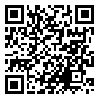Background and purpose: Colors are toxic organic materials with complex structures used in textile production stages such as dyeing, finishing and printing that cause environmental problems. One of the most widely used colorant in textile is reactive blue 19 dye. This study aimed to examine the feasibility of TiO2 as catalysts and sonochemistry process for discoloration of reactive blue 19 from aqueous solutions.
Materials and methods: The study was conducted in laboratory scale. The effect of different parameters affecting the decolorization of reactive blue 19, including the amount of TiO2 nanoparticles, pH, initial dye concentration and the time was investigated. The remaining concentration of RB19 was analyzed by UV-Vis carry 100 spectrophotometer at a wavelength of 592 nm. The response surface methodology was used based on central composite design (CCD) to evaluate the effect of independent variables on the removal efficiency and to predict the best answer. This model with ANOVA analysis confirmed the significant effect of variables.
Results: The experiments and 3D plots showed that higher decolorization was obtained in neutral pH and decolorization efficiency was decreased with increment of initial dye concentration. The highest decolorization was achieved at 62 min and additional time was not effective on decolorization. In current study, 94.7 % discoloration was achieved in optimum conditions, namely 0.08 g/L RB19, pH=6.0, and 1.63 g/L TiO2 at 62.5 min.
Conclusion: The proposed method could be considered as green method for discoloration of colorful pollutant because it does not use oxidant chemicals such as hydrogen peroxide or hypochlorite, which their residues are harmful to the environment.
| Rights and permissions | |
 |
This work is licensed under a Creative Commons Attribution-NonCommercial 4.0 International License. |


